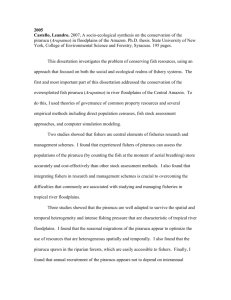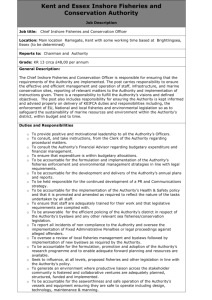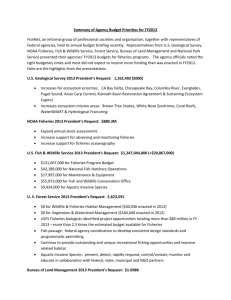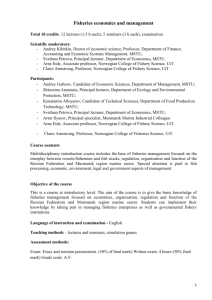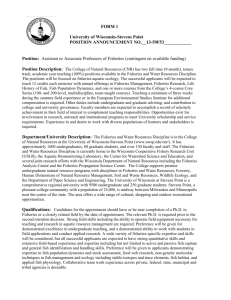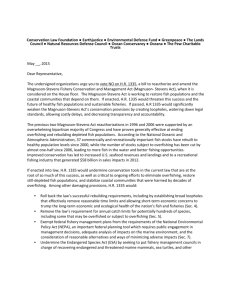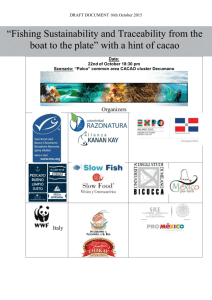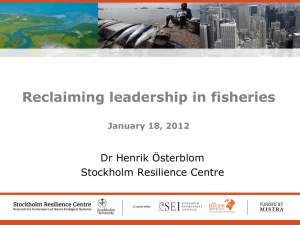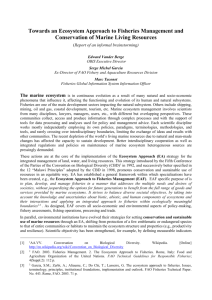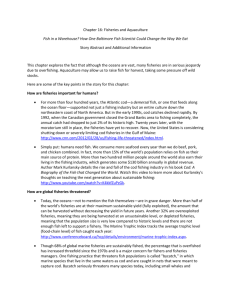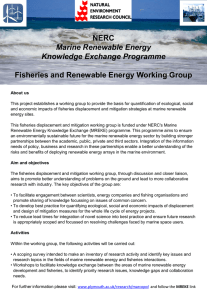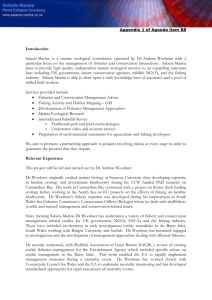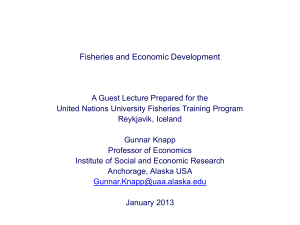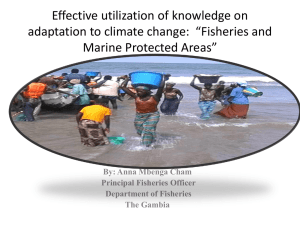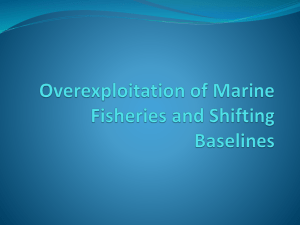The Evolution of the Magnuson-Stevens Act
advertisement
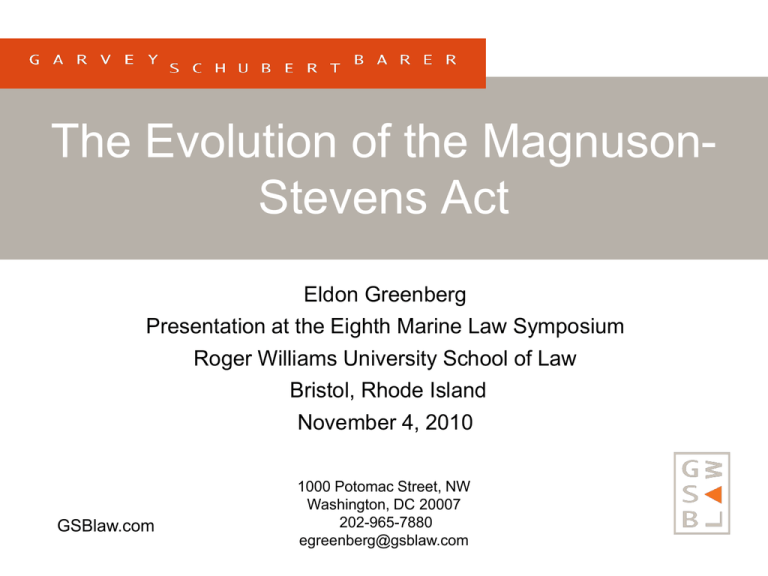
The Evolution of the MagnusonStevens Act Eldon Greenberg Presentation at the Eighth Marine Law Symposium Roger Williams University School of Law Bristol, Rhode Island November 4, 2010 GSBlaw.com 1000 Potomac Street, NW Washington, DC 20007 202-965-7880 egreenberg@gsblaw.com I. INTRODUCTION • Over the past thirty-five years, the Magnuson-Stevens Act has been amended on numerous occasions. • Evolution of the Act comprises five distinct stages: 1974-1976; 1978-1980; 1983 and 1986; 1990; and 1996 and 2007. • Trajectory of the Act: from relative simplicity (34 pages in 1976) to increasing complexity (170 pages in 2007); from fisheries promotion to enhanced conservation. GSBlaw.com 2 II. THE HEROIC ERA – 1974-1976 and the Passage of the Law (Pub. L. No. 94-265). • Major issue in the “heroic era” is jurisdictional: whether a 200 mile “Fishery Conservation Zone” (now the “Exclusive Economic Zone” or “EEZ”) is justified under international law. • Primary goal of the legislation: “kick the foreigners out,” coming especially from New England and Alaska. • Fierce opposition to the legislation from the Defense and State Departments and many elements of the U.S. fishing industry, e.g., tuna and shrimp. • Domestic management is something of an afterthought, to secure the support of non-coastal Senators and Representatives. Still, Council system is a major regulatory innovation. GSBlaw.com 3 II. THE HEROIC ERA – 1974-1976 and the Passage of the Law. (cont.) • System of National Standards, regionally applied, is adopted largely without debate. • Environmental community plays almost no role, except for seeking an extension to 200 miles of the Marine Mammal Protection Act. GSBlaw.com 4 III. ACHIEVING “AMERICANIZATION” – 1978 and 1980 Amendments (Pub. L. Nos. 95-354 and 96-561). • Understanding that mere assertion of jurisdiction is not enough to “Americanize” the fisheries. • Processor Preference Amendment (1978) responds to emerging phenomenon of “joint ventures.” • – Recognition that preference for U.S. fishermen is insufficient. – 1978 amendments establish priority for U.S. fish processors over foreign floating fish processors. American Fisheries Promotion Act (1980) recognizes the need to stimulate the export of U.S. fisheries products. – Institutionalization of the “fish and chips” policy. – Research and development grants aimed at expansion of U.S. fisheries. – Fishery trade officers and fishing vessel loan guarantee program. GSBlaw.com 5 IV. TINKERING AT THE EDGES/CONSOLIDATION OF AUTHORITIES – 1983 and 1986 Amendments (Pub. L. Nos. 97-453 and 99-659). • Reforms of the 1980s grow out of 1982 Oversight Report of the House Merchant Marine and Fisheries Committee (H.R. Rep. No. 97-438). • Thrust of 1983 and 1986 amendments is to overhaul management institutions; modify the process for developing and implementing management measures; and strengthen the enforcement powers of the Federal Government. • 1986 amendments also include the Interjurisdictional Fisheries Act: coordination and funds needed to ensure that adequate measures are applied to non-EEZ, coastal migratory species, e.g., striped bass. GSBlaw.com 6 V. REDISCOVERING INTERNATIONALISM – 1990 Amendments (Pub. L. No. 101-627) • Return to the international focus that dominated the mid-1970s debate. • Growing recognition that, even with the Americanization of EEZ fisheries, effective conservation and management inevitably has an international component. • Focus on pollock in the “donut hole” of the Bering Sea, the dangers of high seas drift gillnet fisheries, the assertion of U.S. jurisdiction over tuna and Secretarial management of Atlantic highly migratory species. GSBlaw.com 7 VI. THE RISE OF ENVIRONMENTALISM – 1996 and 2007 Amendments (Pub. L. Nos. 104-297 and 109-479). • Sea change of the 1990s – the environmental community discovers fishery management. • Sustainable Fisheries Act of 1996 grows out of NMFS’ publication of “Our Living Oceans” documenting “overutilization” of U.S. fisheries, crisis in New England management and the formation of the “Marine Fish Conservation Network.” • Conservation focus of the SFA: eliminating overfishing and rebuilding depleted fish stocks; adopting a “precautionary approach” to management; minimizing by-catch; and protecting marine habitats. – A tilt against “efficiency”, e.g., the amendment of National Standard No. 5. – Balkanization and micro-management. GSBlaw.com 8 VI. THE RISE OF ENVIRONMENTALISM – 1996 and 2007 Amendments. (cont.) • Magnuson-Stevens Reauthorization Act of 2007 continues many of the same themes. – Ending overfishing, establishing firm deadlines for rebuilding, reducing by-catch and enhancing the role of science in management decisions. – Requirements for annual catch limits (“ACLs”), not to exceed the recommendations of the Scientific and Statistical Committee, and accountability measures (“AMs”). – Major new development in 2007: institutionalization of a regime for adopting and implementing “catch share” programs. GSBlaw.com 9 VI. CONCLUSION – What’s next? • A major overhaul is not on the horizon; need for more time to take stock. • Will there be a reaction to the regime’s tilt against efficiency? • Is the system becoming too rigid? Is greater flexibility needed, viz., Amendment 16 to the Multispecies FMP in New England and Congressional calls for modification? • Will New England once again be the driver of legislative change? GSBlaw.com 10
